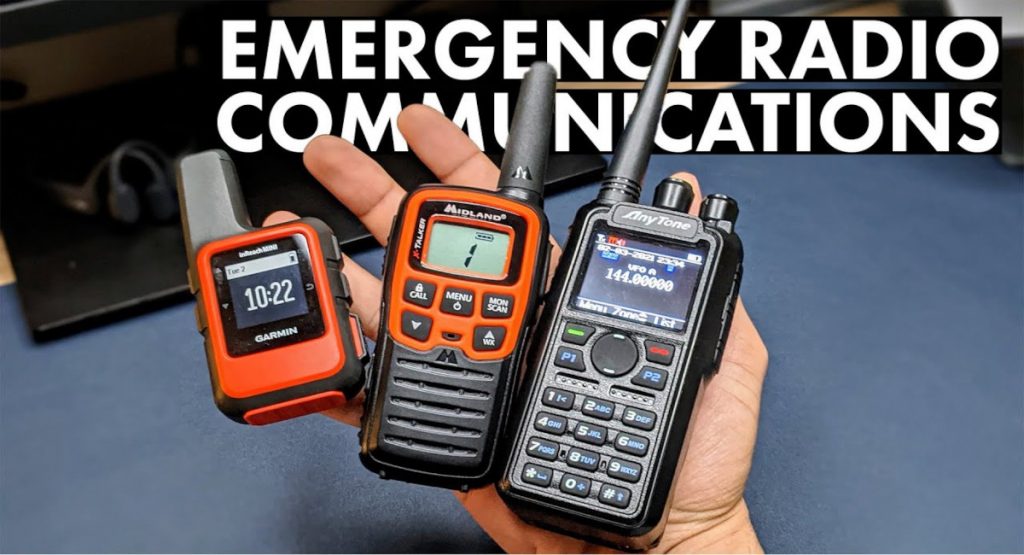Do walkie talkies work in a power outage?
- Because you don’t have to dial a number each time you want to transmit, walkie-talkies are quick and easy to use and best of all, they don’t rely on finicky cell phone signals.
- The handsets transmit directly to each other, so they still work when cell networks fail during natural disasters or power outages.
What is the best communication device during an emergency?
- Two-way radios prove time and time again to be the most reliable form of emergency communication.
- It’s highly advised that you are prepared to utilize more than one form of communication.
Difference between Walkie Talkies
- FRS Frequency Walkie Talkies can be used without a license.
- GMRS Walkie Talkies Require an FCC License – No Exam is required
- Ham Radio HT’s Require a Ham Radio Technician Class License or higher
What is the difference between GMRS, FRS, MURS and the Ham Radio?
FRS: Family Radio Service:
The Family Radio Service (FRS) is a private, two-way, short-distance voice and data communications service for facilitating family and group activities. The most common use for FRS channels is short-distance, two-way voice communications using small hand-held radios that are similar to walkie-talkies. The service is licensed-by-rule so the general public can use the devices without having to obtain a license and channel sharing is achieved through a listen-before-talk etiquette.
The FRS is authorized 22 channels in the 462 MHz and 467 MHz range, all of which are shared with General Mobile Radio Service (GMRS) which requires an individual license for use.
FRS is licensed by rule. This means an individual license is not required to operate an FRS radio provided you comply with the rules. You may operate an FRS radio regardless of your age, and for personal or for business use if you are not a representative of a foreign government.
Channels
There are 22 FRS channels. Each channel has a bandwidth of 12.5 kHz, but the power of each channel may vary as indicated below. All channels are shared with GMRS, so you may hear communications from licensed GMRS stations on these channels.
| Channel No. | Frequency | Power (ERP in Watts) |
|---|---|---|
| 1 | 462.5625 | 2 W |
| 2 | 462.5875 | 2 W |
| 3 | 462.6125 | 2 W |
| 4 | 462.6375 | 2 W |
| 5 | 462.6625 | 2 W |
| 6 | 462.6875 | 2 W |
| 7 | 462.7125 | 2 W |
| 8 | 467.5625 | 0.5 W |
| 9 | 467.5875 | 0.5 W |
| 10 | 467.6125 | 0.5 W |
| 11 | 467.6375 | 0.5 W |
| 12 | 467.6625 | 0.5 W |
| 13 | 467.6875 | 0.5 W |
| 14 | 467.7125 | 0.5 W |
| 15 | 462.5500 | 2 W |
| 16 | 462.5750 | 2 W |
| 17 | 462.6000 | 2 W |
| 18 | 462.6250 | 2 W |
| 19 | 462.6500 | 2 W |
| 20 | 462.6750 | 2 W |
| 21 | 462.7000 | 2 W |
| 22 | 462.7250 | 2 W |
Operating a Family Radio Service (FRS) Unit
- You can operate a FRS transmitter at any place where the FCC regulates radio communications, subject to certain limitations. A FRS transmitter may not be modified and must be certified by the FCC.
- None of the FRS channels are assigned for the exclusive use of any user. You must cooperate in the selection and use of the channels in order to make the most effective use of them and to reduce the possibility of interference.
- The usual range of an FRS device on channels 8-14 is less than one-half mile, but longer range communications can be achieve on channels 1-7 and 15-22 depending on conditions. You may not interconnect FRS transmitters and radios with the telephone system.
GMRS FRS Dual-service radios
- Some manufacturers received approval to market radios that were certified under both FRS and GMRS, which allowed users to use one device to operate on FRS channels, which does not require a license, and GMRS, which requires an FCC license. In 2017, the FCC changed its rules to stop equipment authorization of FRS dual-service radios and it changed the rules for both FRS and GMRS such that existing radios would be reclassified as either FRS or GMRS to remove the confusion of whether a license was needed for legal operation.
- Specifically, if you have a radio that was sold as a dual-service FRS/GMRS radio and it is limited to the channels and power limits provided under the “Data” tab on this page, then that device can be operated as an FRS device without a licensing requirement. However, if the device exceeds the limits under the “Data” tab or includes any of the following channels (467.5500, 467.5750, 467.6000, 467.6250, 467.6500, 467.6750, 467.7000, and 467.7250 MHz), then it is a GMRS device and an individual FCC license is needed to operate the device other than on the channels and with the bandwidth and power limits shown under the “Data” tab.
FCC.gov
GMRS: General Mobile Radio Service
- The General Mobile Radio Service (GMRS) is a licensed radio service that uses channels around 462 MHz and 467 MHz. The most common use of GMRS channels is for short-distance, two-way voice communications using hand-held radios, mobile radios and repeater systems. In 2017, the FCC expanded GMRS to also allow short data messaging applications including text messaging and GPS location information.
- Services that provide functionality similar to GMRS include the Citizens Band Radio Service (CBRS), the Family Radio Service (FRS) and the Multi-Use Radio Service (MURS).
- The GMRS is available to an individual (one man or one woman) for short-distance two-way communications to facilitate the activities of licensees and their immediate family members. Each licensee manages a system consisting of one or more transmitting units (stations.) The rules for GMRS limit eligibility for new GMRS system licenses to individuals in order to make the service available to personal users. (Some previously licensed non-individual systems are allowed to continue using GMRS.)
- In 2017, the FCC updated the GMRS by allotting additional interstitial channels in the 467 MHz band, increased the license term from 5 to 10 years, allowed transmission of limited data applications such as text messaging and GPS location information and made other updates to the GMRS rules to reflect modern application of the service.
- An FCC license is required to operate GMRS system. Licenses are issued for a ten-year term and can be renewed between 90 days prior to the expiration date and up to the actual expiration date of the license. After a license expires, an individual must request a new GMRS license.
- A GMRS system licensed to a non-individual prior to July 31, 1987 is also eligible for renewal, but the licensee may not make any major modification to the system.
- You may apply for a GMRS license if you are 18 years or older and not a representative of a foreign government. If you receive a license, any family member, regardless of age, can operate GMRS stations and units within the licensed system.
Channels
There are 30 GMRS channels with a bandwidth of 25 kHz (20 KHz authorized bandwidth) or 12.5 kHz as outlined below:
| Channel | Authorized Bandwidth |
|---|---|
| 462.5500 | 20 kHz |
| 462.5625 | 20 kHz |
| 462.5750 | 20 kHz |
| 462.5875 | 20 kHz |
| 462.6000 | 20 kHz |
| 462.6125 | 20 kHz |
| 462.6250 | 20 kHz |
| 462.6375 | 20 kHz |
| 462.6500 | 20 kHz |
| 462.6625 | 20 kHz |
| 462.6750 | 20 kHz |
| 462.6875 | 20 kHz |
| 462.7000 | 20 kHz |
| 462.7125 | 20 kHz |
| 462.7250 | 20 kHz |
| 467.5500 | 20 kHz |
| 467.5625 | 12.5 kHz |
| 467.5750 | 20 kHz |
| 467.6125 | 12.5 kHz |
| 467.6000 | 20 kHz |
| 467.6625 | 12.5 kHz |
| 467.6250 | 20 kHz |
| 467.7125 | 12.5 kHz |
| 467.6500 | 20 kHz |
| 467.5875 | 12.5 kHz |
| 467.6750 | 20 kHz |
| 467.6375 | 12.5 kHz |
| 467.7000 | 20 kHz |
| 467.6875 | 12.5 kHz |
| 467.7250 | 20 kHz |
- A GMRS licensee may use a combination of portable, mobile, fixed and repeater stations consistent with the operational and technical rules in Subpart E of Part 95. The use of some channels is restricted to certain types of stations and certain channels are reserved for voice-only operations, while other channels allow voice and data operations.
- None of the GMRS channels are assigned for the exclusive use of any system. You must cooperate in the selection and use of the channels in order to make the most effective use of them and to reduce the possibility of interference.
- You can expect a communications range of one to twenty-five miles depending on station class, terrain and repeater use. You cannot directly interconnect a GMRS station with the telephone network or any other network for the purpose of carrying GMRS communications, but these networks can be used for remote control of repeater stations.
- Normally, you and your family members would communicate between yourselves directly or through a repeater station. The stations must be within the territorial limits of the fifty United States, the District of Columbia, and the Caribbean and Pacific Insular areas.
- In transient use, a mobile station from one GMRS system may communicate through a mobile relay station (repeater) in another GMRS system with the permission of its licensee. The communications may also be with mobile stations from other GMRS systems also with permission from the licensee to communicate through the mobile relay station.
FCC.gov
MURS: Multi-Use Radio Service
The Multi-Use Radio Service (MURS) uses channels in the 151 – 154 MHz spectrum range. The most common use of MURS channels is for short-distance, two-way communications using small, portable hand-held radios that function similar to walkie-talkies.
MURS is authorized five channels that were previously in the industrial/business radio service and were known as the “color dot” frequencies in Part 90 of the FCC rules.
Channels
There are five MURS channels and the channels are either 11.25 kHz or 20.00 kHz each. The channel
frequencies and (bandwidth) are:
- 151.820 MHz (11.25 kHz)
- 151.880 MHz (11.25 kHz)
- 151.940 MHz (11.25 kHz)
- 154.570 MHz (20.00 kHz)
- 154.600 MHz (20.00 kHz)
- MURS is licensed by rule. This means an individual license is not required for an entity to operate a MURS transmitter if it is not a representative of a foreign government and if it uses the transmitter in accordance with the MURS rules outlined in 47 C.F.R. Part 95 Subpart J.
- There is no age restriction regarding who may operate an MURS transmitter.
- You may operate a MURS transmitter at any location the FCC regulates radio communications, subject to certain restrictions. A MURS transmitter must be certified by the FCC.
- None of the MURS channels are assigned for the exclusive use of any user. You must cooperate in the selection and use of the channels in order to make the most effective use of them and to reduce the possibility of interference.
- No MURS transmitter shall, under any condition of modulation, transmit more than 2 watts transmitter power output.
- The usual range of communications between MURS stations is less than a few miles; connecting a MURS radio to an external antenna can extend the range to ten miles or more. MURS stations are not allowed to be interconnected with the public switched telephone network. A station identification announcement is not required to be transmitted. Other restrictions on the use of MURS stations also apply.
FCC.gov
Ham Radio Handheld Transceiver:
- The amateur and amateur-satellite services are for qualified persons of any age who are interested in radio technique solely with a personal aim and without pecuniary interest. These services present an opportunity for self-training, intercommunication, and technical investigations.
- Twenty-nine small frequency bands throughout the spectrum are allocated to this service internationally. Some 1,300 digital, analog, pulse, and spread-spectrum emission types may be transmitted.
- Ham Radio operations require an FCC “Technician Class, General Class , Extra Class license”.
- Do not purchase a Ham Radio unless you are licensed by the FCC.
- Federal law generally prohibits radio broadcasts without a license issued by the FCC. Anyone found operating a radio station without FCC authorization can be subject to a variety of enforcement actions, including seizure of equipment, fines and other civil and criminal penalties.
FCC.gov










